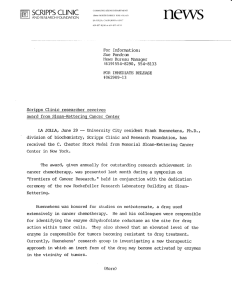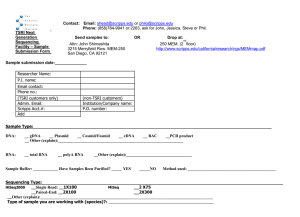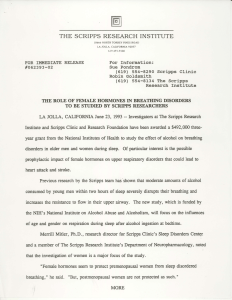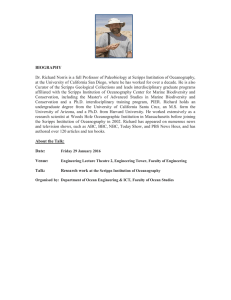SCRIPPS DISCOVERS The Scripps Research Institute, McDonald’s
advertisement
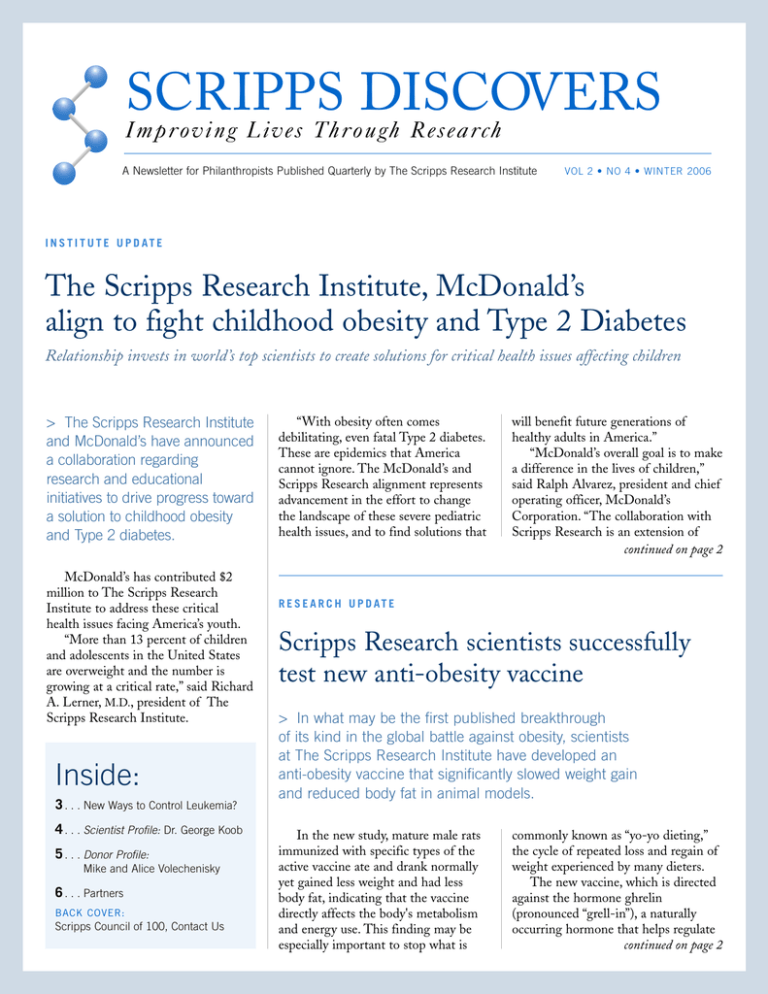
SCRIPPS DISCOVERS Imp ro v i n g L i v e s T hr o u g h R esea r ch A Newsletter for Philanthropists Published Quarterly by The Scripps Research Institute VOL 2 • NO 4 • WINTER 2006 I N S T I T U T E U P D AT E The Scripps Research Institute, McDonald’s align to fight childhood obesity and Type 2 Diabetes Relationship invests in world’s top scientists to create solutions for critical health issues affecting children > The Scripps Research Institute and McDonald’s have announced a collaboration regarding research and educational initiatives to drive progress toward a solution to childhood obesity and Type 2 diabetes. McDonald’s has contributed $2 million to The Scripps Research Institute to address these critical health issues facing America’s youth. “More than 13 percent of children and adolescents in the United States are overweight and the number is growing at a critical rate,” said Richard A. Lerner, M.D., president of The Scripps Research Institute. Inside: 3 . . . New Ways to Control Leukemia? 4 . . . Scientist Profile: Dr. George Koob 5 . . . Donor Profile: Mike and Alice Volechenisky 6 . . . Partners BACK COVER: Scripps Council of 100, Contact Us “With obesity often comes debilitating, even fatal Type 2 diabetes. These are epidemics that America cannot ignore. The McDonald’s and Scripps Research alignment represents advancement in the effort to change the landscape of these severe pediatric health issues, and to find solutions that will benefit future generations of healthy adults in America.” “McDonald’s overall goal is to make a difference in the lives of children,” said Ralph Alvarez, president and chief operating officer, McDonald’s Corporation. “The collaboration with Scripps Research is an extension of continued on page 2 R E S E A R C H U P D AT E Scripps Research scientists successfully test new anti-obesity vaccine > In what may be the first published breakthrough of its kind in the global battle against obesity, scientists at The Scripps Research Institute have developed an anti-obesity vaccine that significantly slowed weight gain and reduced body fat in animal models. In the new study, mature male rats immunized with specific types of the active vaccine ate and drank normally yet gained less weight and had less body fat, indicating that the vaccine directly affects the body's metabolism and energy use. This finding may be especially important to stop what is commonly known as “yo-yo dieting,” the cycle of repeated loss and regain of weight experienced by many dieters. The new vaccine, which is directed against the hormone ghrelin (pronounced “grell-in”), a naturally occurring hormone that helps regulate continued on page 2 TSRI and McDonald’s align, CONTINUED The four who made it happen: The Scripps Research Institute’s Vice President of Development Denise M.Scalzo; President and Chief Operating Officer of McDonald’s Corporation Ralph Alvarez; The Scripps Research Institute’s Director of Community Outreach and Education Katja Van Herle, M.D., M.S.P.H.; and Ronald McDonald House Charities Board Member and McDonald’s Restaurants Owner/Operator Steve Ramirez. Anti-obesity vaccine, children today. Additional research, increased awareness and education, and monitoring the disease are essential for finding a longterm solution,” said Van Herle, a physician and director of the Institute’s Department of Community Outreach and Education. “We must proactively address and offer solutions for pediatric obesity . . . and commitment to researching solutions for these issues is essential,” said Robert Verloop, former chairman of the board, Produce for Better Health. “We applaud McDonald’s for engaging in research initiatives with Scripps, and for its ongoing leadership in adding new menu choices.” CONTINUED energy balance in the body, has shown the potential, in animal models at least, to put an end to that risky and often futile struggle. These findings may mark a turning point in the treatment of obesity by confirming the effectiveness of immunopharmacotherapy to combat this serious and growing global problem. Immunopharmacotherapy engages the immune system, specifically antibodies, to bind to selected targets, directing the body's own immune response against them. This approach is being tested in a number of other areas including drug addiction, especially addiction to cocaine and nicotine. “The study shows our vaccine slows weight gain and decreases stored fat in rats,” said a senior author of the paper, Kim Janda, Ph.D., who is Ely R. Callaway, Jr. Professor of Chemistry at Scripps Research, a member of The 2 | SCRIPPS DISCOVERS McDonald’s long-standing commitment to the well-being of children around the world.” The relationship unites Scripps Research’s worldrenowned scientists committed to ground-breaking scientific research addressing pediatric health concerns with McDonald’s 50-year legacy of supporting programs that promote children’s health and wellness. The biomedical research will be under the auspices of the newly created McDonald’s Center for Type 2 Diabetes and Obesity. Guiding the initiative for Scripps Research is Katja Van Herle, M.D., M.S.P.H. “As both a scientist and a mom, I understand, firsthand, the issues that face our WINTER 2006 “The study shows our vaccine slows weight gain and decreases stored fat in rats . . .” Dr. Kim Janda, Ely R. Callaway, Jr. Professor of Chemistry Skaggs Institute for Chemical Biology, and director of the WORM Institute of Research and Medicine. “While food intake was unchanged in all testing groups, those who were given the most effective vaccines gained the least amount of weight. To have an impact on appetite and weight gain, ghrelin first has to move from the stomach where it is produced into the brain — where it stimulates hunger and the retention of a level of stored energy as fat. Our study is the first published evidence proving that preventing ghrelin from reaching the central nervous system can produce a desired reduction in weight gain.” “We’re not claiming that our study answers the question of obesity treatment once and for all,” Janda said. “What we are saying — and what our study confirms — is that this looks like a serious workable solution to the problem. And while much more research is needed to understand the continued on page 3 R E S E A R C H U P D AT E The results showed mice receiving AML1-ETO9a-expressing blood cell Study shows newly discovered genetic abnormality causes acute myeloid leukemia > Working in collaboration with international researchers, scientists from The Scripps Research Institute have uncovered a new genetic abnormality that results in the rapid development of acute myeloid leukemia (AML) in animal models. These findings could lead to new ways of diagnosing and controlling development of a variety of human diseases, including leukemia and other cancers that result from certain types of genetic defects. In the study, the researchers report that a previously unknown form of a fusion protein called AML1-ETO9a taken from patient samples “leads to rapid development of leukemia in a mouse blood cell transplantation model.” The newly discovered protein results from a chromosomal translocation — the exchange of material between dissimilar Anti-obesity vaccine, chromosomes often resulting in the fusing of unrelated genes. These new genes express fusion proteins such as AML1-ETO9a that can produce a host of biological mistakes. transplantation showed signs of the leukemia with anemia, high white blood cell count, and abnormal differential counts. Those receiving only the AML1-ETO protein, the most commonly known fusion protein from this particular chromosomal translocation, remained healthy. “We thought the AML1-ETO9a protein from patients might cause the onset of leukemia,” said Scripps Research Associate Professor Dong-Er Zhang, Ph.D., who led the study. “Indeed, the AML1-ETO9a fusion protein has shown a clear and strong potential to induce the development continued on page 4 “. . . We hope this discovery will help in the development of future treatments” for this devastating disease.” Dr. Dong-Er Zhang CONTINUED full therapeutic potential of immunopharmacotherapy in combating obesity, these initial results are extremely positive. Right now it appears that active vaccination against ghrelin is one avenue that can slow weight gain and fat build-up in the body.” Obesity remains a serious and growing problem for millions of people worldwide and is a contributing risk factor for a number of other diseases including heart disease, various cancers, Type 2 diabetes, stroke, arthritis, and depression. Although a number of pharmaceutical approaches have been taken to try to help people better control their body weight, few if any have been successful and several, including the drugs fenfluamine (a component of “Fen-Phen”) and ephedrine, have been pulled from the market by the U.S. Food and Drug Administration. According to recent reports from the World Health Organization, about 1 billion people worldwide are overweight or obese, most of them in the developed world. In the United States, for example, the National Health and Nutrition Examination Survey found that, in 2003 to 2004, approximately 66 percent of all American adults 20 years of age or older were overweight or obese. Almost four out of every five American men aged 40 to 59 were classified as overweight, according to a 2006 study published by the Journal of the American Medical Association. Even Japan, long a dietary exception, has experienced a rise in obesity and diabetes as Westernstyle eating habits continue to take hold in that country. Eric Zorrilla, Ph.D., a Scripps Research assistant professor, member of the Harold L. Dorris Neurological Research Institute, and a lead author of the study, said, “The rats who received the most effective vaccines didn't eat differently than the others, including the control models. That makes our findings exciting therapeutically — the vaccine slows the rate of weight gain, while still allowing for normal eating habits.” The study was supported by the National Institute of Diabetes, Digestive, and Kidney Disorders and The Skaggs Institute for Chemical Biology. SCRIPPS RESEARCH INSTITUTE | 3 Acute myeloid leukemia, CONTINUED of leukemia, at least in animal models. Since chromosomal translocation is one of the most common genetic abnormalities in AML, we hope this discovery will help in the development of future treatments for this devastating disease.” AML — the most common form of acute leukemia in adults — is a disease of the bone marrow and blood. Normally, hematopoietic stem cells, which are found in adult bone marrow and other places, produce red blood cells, platelets, and white blood cells. In AML, instead of maturing normally, blood cells remain in an abnormal, immature form. As these abnormal cells proliferate, there is less and less room for healthy blood cells, causing patients to experience symptoms such as infection, anemia, and bleeding. According to the American Cancer Society, more than 9,000 deaths from AML will occur in the United States during 2006. The new study made an additional finding about the fusion protein, AML1-ETO, which alone is not SCIENTIST PROFILE George Koob — In pursuit of treatments for alcoholism > “Most people in this country drink,” says Scripps Research Professor George F. Koob, “yet only some become alcoholics. Why? That’s the question we’re trying to answer.” Koob, the Director of the Pearson Center for Alcoholism and Addiction Research, has been studying the neurobiology of alcohol and alcoholism for several years, and he has developed models of normal and excessive drinking to study the neuro-physiological correlates of alcohol consumption. His studies start with the brain — and the neurobiology of alcohol in the brain — some of which we understand, and some of which is only now coming to light. The National Institute on Alcohol Abuse and Alcoholism (NIAAA) recently funded a five-year, $38 million grant to support a consortium led by Koob. The multi-institutional group aims to identify the molecular basis of alcoholism, establishing a platform upon which future treatments can be built. Alcoholism, a chronic disease characterized by compulsive use of 4 | SCRIPPS DISCOVERS WINTER 2006 Dr. George Koob, Director, Pearson Center for Alcoholism and Addiction Research “How molecular changes occur to make one person more vulnerable to addiction than another is really the key to the addiction process.” alcohol and loss of control over alcohol intake, is devastating both to individuals and their families and to society in leukomogenic. However, its co-expression with AML1-ETO9a does result in the “substantially earlier onset of AML.” This may indicate that these two proteins may work together to induce cancer development, the researchers said. Notably, the relative amount of both proteins varies among samples from individuals with AML, suggesting their expression may provide clues to these patients’ prognosis. general. About a third of the approximately 40,000 traffic fatalities every year involve drunk drivers, and direct and indirect public health costs are estimated to be in the billions of dollars yearly. In addition to its enormous toll on families and society at large, alcoholism is devastating to an individual’s health because of the damage that excessive amounts of alcohol cause to the system over time. Whether it is the liver or the heart or some other organ, says Koob, “Ultimately, alcoholism gets you as some part of your body goes.” During the next five years, the researchers plan to use molecular, cellular, and physiological methods to identify specific clusters of genes whose expression is regulated by alcohol and to confirm nominated gene targets. The consortium encourages the integration of diverse studies in the field. For instance, a meta-analysis of knockout-mouse studies examined more than 4.5 million data points on more than 100 microarrays, identifying some 3,800 unique genes and 1,300 functional groups that may determine a predisposition for a high degree of alcohol intake. “The meta-analysis simply would not have happened without the consortium,” Koob says. “The consortium as a whole is greater than its individual components.” continued on page 5 DONOR PROFILE Mike and Alice Volechenisky: Combining a love of science with finance ike Volechenisky has always been fascinated with science. In fact, when Mike and his wife Alice recently decided to contribute $1 million to charity by setting up charitable gift annuities, they chose Scripps Research M “There are always new things to discover and we hope our gift will help — you can take one peel off the onion, but there’s more to follow.” Mike and Alice Volechenisky George Koob, as the major beneficiary — $690,000 will be used for biomedical research at the Institute, with Bucknell University, Alice’s alma mater, receiving the remaining $310,000 — to be used for scientific research and scholarships. Asked why they decided to direct a large portion of their philanthropy to Scripps Research, Mike replied, “I’m a great reader of scientific literature and have come across the Institute a number of times. I believe that Scripps’ outstanding researchers and scholars have contributed many seminal discoveries and will continue their superior efforts in their chosen fields. There are always new things to discover and we hope our gift will help — you can take one peel off the onion, but there’s more to follow.” Through the charitable gift annuity to Scripps Research, the Volechenisky’s have irrevocably transferred assets to the Institute. In return, the Institute makes fixed annual payments to them for life. The Volechenisky’s were also able to take an immediate charitable deduction for a portion of the gift’s value. CONTINUED In addition to Scripps Research and the University of Texas, the consortium’s primary sites are: Oregon Health and Science University in Portland; Stanford University and SRI International in Stanford, California; Indiana University Medical Center in Indianapolis; and University of Colorado Health Sciences Center in Denver. Also at Scripps Research are the NIAAA-funded Scripps Research Institute Alcohol Research Center, which focuses on neurobiology of alcohol dependence, and the Pearson Center for Alcoholism and Addiction Research, which is devoted to medication development. Koob recently published an ambitious and thought-provoking new book, “Neurobiology of Addiction,” that emphasizes how rapidly the neurobiology of addiction has emerged and grown as a research field. Some 30 years ago, we knew almost nothing about the neurobiological mechanisms of addiction. Koob has made major contributions to the field. “Our gift annuity eliminates my concerns about constant investment decisions, the state of the economy, and other considerations,” said Mike. “The endowment assets are professionally managed in accordance with prudent investor rules.” “It allows us to make a lasting contribution to science, while still providing a safety net of income for us should we need it,” said Mike. “We can use the funds in our retirement years. The return on the charitable gift annuity is good, and it’s not subject to economic downturns like bonds — it’s backed by a big endowment and income from the endowment should see us through and keep us comfortable.” Finishing service in the Army Air Corps as a pilot of B-24 and B-17 bombers during 30 missions over Europe in World War II, Mike chose to conquer the financial world. He spent almost two years in New York working on the New York Stock Exchange when the daily volume was between 500 and 700 thousand shares per day. He then decided to return to his home town and went to work for the F.I. DuPont Company’s Elmira, New York office, where he worked for 21 years. Mike is an accomplished woodworker — much of the Volechenisky home is furnished with his beautiful work. Mike builds mostly mahogany reproductions of classical designs, with Chippendale a favorite. Mike and Alice have been married for over 55 years. Alice, a retired school teacher, enjoys cross stitching amongst a variety of other interests. Mike and Alice have traveled to the Soviet Union, Argentina, Uruguay, Paris and all over the world — preferring the first-hand experience to merely reading about exotic locales. Their gift is helping assure service to humanity through scientific discovery, contributing to a horizon beyond our scope of imagination. If you would like information about how you could make a gift which would provide you with income for life, please contact our Planned Giving Counsel, Cheryl H. Dean, Esq. at (858) 784-2380 or cdean@scripps.edu. SCRIPPS RESEARCH INSTITUTE | 5 Partners 2 1 3 1 In celebration of the second annual gathering of The Scripps Legacy Society this spring, Scripps Research planned giving donors and Kellogg School of Science and Technology students enjoyed a reception and luncheon at the Estancia La Jolla Hotel and Spa. The Scripps Legacy Society is composed of individuals who have included Scripps Research as a beneficiary in their estate plans. Pictured at the event are planned giving donors Brian and Ann McDonald. 2 Craig Chaquico, renowned lead guitarist of Jefferson Airplane and Starship fame and acclaimed solo contemporary instrumental artist, performed at a 6 | SCRIPPS DISCOVERS WINTER 2006 dinner benefiting the Molly Baber Research Fund at Scripps Research this summer. The intimate evening was held under the stars at the Bernardo Heights Country Club. All proceeds from the evening went to the Molly Baber Research Fund for Diabetes and Transplantation Medicine, created by Mark Baber in honor of his wife. Research for the fund is conducted by the Scripps Research laboratory of Dr. Daniel Salomon that focuses on the latest technology to advance genomic medicine in transplantation. Pictured at the event are Craig Chaquico, Mark Baber, and Dan Salomon. 3 The Scripps Research/ McDonald’s alignment to fight childhood obesity and Type 2 diabetes (please see front page) was announced at the annual donor appreciation dinner this summer, which celebrated major donors to Scripps Research. In attendance at the event, held in the Beckman Center for Chemical Sciences atrium on the La Jolla campus, were some 150 people. Pictured here are Claudia S. Luttrell, a trustee and a member of the Skaggs family, which donated $100 million to found The Skaggs Institute for Chemical Biology and which established the Skaggs Oxford Scholarships, and Jeffery Kelly, Ph.D., Dean of Graduate and Postgraduate Studies and Lita Annenberg Hazen Professor of Chemistry at The Scripps Research Institute. 4 5 4 The Unforgettable Fund (www.theunforgettablefund.com), a not-for-profit organization, acts as a direct donation “pathway” to Alzheimer’s research at Scripps Florida, to help rapidly discover and develop drugs using the same state-of-the-art technologies as the pharmaceutical industry. Pictured here are Gertrude McNally and Patty Doherty of The Unforgettable Fund, presenting the first check for $10,435 to support Alzheimer’s research at Scripps Florida to Scripps Florida’s Vice President of Scientific Support Operations Dr. Harry Orf and Assistant Professor Dr. Malcolm Leissring. “When my dad was sick, I would have given anything to have someone explain to me — on a level I could understand — what was happening to him,” said Patty Doherty. “Dr. Leissring has accomplished that. I believe his explanations would be a great help to all who suffer from the effects of this disease . . . and serve as an assurance that the brightest, most committed minds are working to unmask this deadly culprit.” 5 Scripps Florida Professor of Infectology, A. Donny Strosberg, Ph.D., presented to an audience of corporate and private donors at a recent Scripps Florida Corporate Club luncheon. Dr. Strosberg has emerged as one of Scripps Florida’s most active and articulate thought-leaders in explaining and facilitating new biotechnology business which can be built around Scripps Florida and the state’s newest economic “hot button.” Pictured here are Scripps Research Trustee Alex Dreyfoos; with corporate club members Gary Lickle, Managing Director, Lehman Brothers, Palm Beach; and William A. Meyer, Chairman, Meyer Jabara Hotels. SCRIPPS RESEARCH INSTITUTE | 7 The Scripps Council of 100 > The Scripps Council of 100 consists of individuals, couples, and representatives of corporations or foundations that contribute $100,000 annually or make a single contribution of $1 million or more to The Scripps Research Institute. John J.* and Rebecca Moores Rancho Santa Fe, California National Multiple Sclerosis Society New York, New York NLM Family Foundation Nancy Lurie Marks Boston, Massachusetts Office Depot Mary Wong Delray Beach, Florida Mark E. Pearson Palo Alto, California Alafi Family Foundation Margaret Alafi, Ph.D. Berkeley, California American Cancer Society Carolyn D. Runowicz, M.D. Atlanta, Georgia American Heart Association Robert Eckel, M.D. Dallas, Texas Gordon M. Anderson Charitable Lead Trust Los Angeles, California Arthritis Foundation John C. Whelton, M.D. Palm Beach, Florida William M. and Sharon Bauce Rancho Santa Fe, California Donald E. and Delia B. Baxter Foundation Donald B. Haake Rancho Santa Fe, California Arnold and Mabel Beckman Foundation Irvine, California Becton Dickinson and Company Franklin Lakes, New Jersey Bruce and Anne Bundy Foundation Long Beach, California Burroughs Wellcome Fund Research Triangle Park, North Carolina Cancer Research Institute New York, New York George H.* and Patsy Conrades Hobe Sound, Florida Richard A. and Alice D. Cramer New York, New York Howard Hughes Medical Institute Chevy Chase, Maryland Cytel Corporation (Epimmune) San Diego, California Juvenile Diabetes Research Foundation Robert Wood Johnson IV New York, New York Rockefeller Foundation James F. Orr III New York, New York W.M. Keck Foundation Los Angeles, California Donald** and Lois Roon La Jolla, California W. Keith** and Janet R. Kellogg II*** Rancho Santa Fe, California Damon Runyon Cancer Research Foundation New York, New York Lawrence J. and Florence A. De George Jupiter, Florida Harold L. Dorris Neuroscience Foundation Helen L. Dorris Foundation La Jolla, California Pitman Moore, Inc. (Mosaic) Minneapolis, Minnesota Alexander W.* and Renate Dreyfoos West Palm Beach, Florida William R. Kenan Charitable Trust Richard M. Krasno, Ph.D. Chapel Hill, North Carolina George T. and Wilma Elmore Gulf Stream, Florida Eugene V.** and Joyce F. Klein Los Angeles, California Charles E. Scripps Naples, Florida Dr. Richard A.* and Dr. Nicola Lerner La Jolla, California Robert P. Scripps, Jr. Fredericksburg, Texas Leukemia and Lymphoma Society White Plains, New York Samuel H. Scripps Rhinebeck, New York Ellison Medical Foundation Bethesda, Maryland The Factor Foundation Kim Madeiros Boca Raton, Florida Elizabeth Fago Palm Beach Gardens, Florida Lucille P. Markey Charitable Trust Miami, Florida John and Joy Safer McLean, Virginia Mr. and Mrs. L.S. Skaggs Eagle, Idaho Rodney B.** and Marjorie S. Fink* Palm Beach, Florida G. Harold & Leila Y. Mathers Charitable Foundation James H. Handelman Mount Kisco, New York Jim and Sue Gilstrap Carlsbad, California McDonald’s® Corporation Oak Brook, Illinois Buddy Taub Foundation Dennis A. Roach Los Angeles, California Wayne R. Green La Jolla, California Thomas F. and Kathy Mendoza Beverly Hills, California Andrew J.* and Erna F. Viterbi La Jolla, California Ernest W. and Jean Hahn Charitable Trust San Diego, California Michaux Family Foundation Richard and Virginia Michaux Saint Helena, California Mike and Alice Volechenisky Hemet, California Lita Annenberg Hazen Foundation Cynthia H. Polsky Boca Raton, Florida Mid-Atlantic Connection for PKU & Allied Disorders Lancaster, Pennsylvania *Trustee ** Deceased *** Trustee Emeritus Contact us: For more information about Scripps Research, visit our web page at www.scripps.edu/philanthropy To learn more about giving, please contact: Denise M. Scalzo Vice President, Development 10550 N. Torrey Pines Road TPC-2 La Jolla, California 92037 (858) 784-9367 or (800) 788-4931 scalzo@scripps.edu Iva Swayne Orange, California
